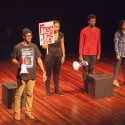Future artists showcase talents in ‘The Chancellor Presents’

Graduate student Jawana Williams practices an African dance during a rehearsal of “Equatorial Rhythms” at Lathrop Hall. The dance is one of several performances to be featured during “The Chancellor Presents: UW Performing Artists of the Future,” a music, drama and dance event to be held Saturday, Feb. 25, at Overture Hall. Photos: Jeff Miller
The arts are not only a means of personal expression. Ideas also regularly travel the compelling highways that the arts of all kinds provide.
Case in point: The ideas embedded in the works that apprentice artists — students — are exploring and articulating in “The Chancellor Presents the Performing Artists of the Future: A World Class Evening of Music, Drama and Dance,” Saturday, Feb. 25, at the Overture Center.
In Carlos Chavez’s “Sinfonia India,” performed by the UW–Madison Symphony Orchestra, students and audience members will be able to see how the composer fused native melodies and rhythms of the Yacqui, Seri and Huichols peoples and formal techniques employed by modern music of their times.
Another musical fusion takes place in “Equatorial Rhythms,” directed by Claudia Melrose, professor of dance and chair of the UW–Madison dance program. The piece draws on dances from West Africa, Spain and Cuba — hybrid cultures themselves. Jin-Wen Yu, associate professor of dance, explores the social problem of homelessness, as well as the creation of community, in his piece “Nesting.”
Students and their audiences travel to the other side of the world — Japan, to be precise — in “A Kabuki Okonomi — a Taste of This and That.” The piece, complete with spoken monologues, a highly choreographed fight sequence and traditional dance, provides a cultural introduction to an ancient and sophisticated culture.
The students are opening themselves quickly to the insights, challenges and new experiences that the pieces in this presentation afford.
Kathleen Coughlin, a senior in the music education program, dribbles sheet music from her folder as she walks down the hall these days. “I’m simultaneously preparing for this concert and a concerto concert. But in the real world of classical music, musicians have very few rehearsals to get together large quantities of music, so this is a foreshadowing of my future in music!” she says.

James Smith, director of the UW Symphony Orchestra and professor in the School of Music, conducts student musicians playing during a rehearsal at Mills Hall in the Mosse Humanities building.
Coughlin is an oboist, and she also plays the English horn. Regardless of the instrument or the setting, she says that music is an essential part of her life, one that she would be hard pressed to do without.
“When I play by myself, I make the music my own by creating a story through the musicality and musical line. In an orchestra setting, I’m conscious of being part of a whole, joining with many others to make something that’s sometimes beautiful, harsh or heart-wrenching,” she says.
Merrin Mitchell also relishes being a part of something larger than herself. A Ph.D. candidate in choral conducting with a minor in vocal performance, she is the graduate assistant for the UW–Madison Concert Choir. As such, she is responsible for running sectionals for choir members who are new to the ensemble or need help with their parts.
Mitchell says that she also feels a vibrant connection with the composers whose work she performs.

Holly Blomquist, a graduate student in lighting design, adjusts stage lights mounted in the catwalk above Mitchell Theatre in Vilas Hall for an upcoming production. Blomquist is also working on lighting design for a kabuki performance to be featured during “The Chancellor Presents: UW Performing Artists of the Future.”
“We, as performers, need to communicate clearly the sense of symmetry and cohesion involved in a choral/orchestra work. Through this unified effort the beauty of the composer’s vision should inspire both performers and listeners to understand the human condition we all share,” Mitchell says.
Part of that human condition involves hard work.
“What am I proudest of in this production? Being able to make it through it — this is physically taxing!”
Megan Simmons is one of the dancers in “Equatorial Rhythms.” Despite the hard body work she is investing in the piece, she is reaping immediate gratification, she says.
“The rhythms become internal they’re so high energy and intense. It’s a lot of fun to put those things through your body!” she says.
Next winter, Simmons, a sophomore in dance and pre-physical therapy, plans to study West African dance in Guinea, as did her instructor Otehlia Kiser, a lecturer in the dance program. It was Kiser who chose the dancers for The Chancellor Presents event.
“I looked for dancers who could hear and respond to the rhythms, and who could show good technique and performance style,” Kiser says.

Undergraduate student Kathleen Coughlin plays the oboe during a UW Symphony Orchestra rehearsal at Mills Hall in the Mosse Humanities building. The symphony is one of several groups to be featured during the Feb. 25 event.
The dancers will need all of the above to successfully execute the intricate footwork in the pieces, Melrose says.
“I conceived the relationship of the dances — West African, Haitian and Cuban, Spain, Flamenco, Caribbean — to the diaspora of peoples from those countries,” she says. “The connections are very evident in many aspects of the rhythms.”
Rachel Eliasek, a sophomore majoring in elementary education and Spanish, says that “Equatorial Rhythms” is making it possible for her to discover aspects of and connections to cultures quite different from her own.
“The type of dance conveys the spirit of the people,” she says. “Dance is a huge part of other cultures and emphasizes the importance of family and community.
“The feeling is, it’s good for both the body and the spirit.”
Joanna Anderson will be dancing in The Chancellor Presents too, but will be performing works in a very different style and from a very different time and place than Simmons and Eliasek.
Anderson, a junior majoring in theater and English, will be presenting a series of kabuki dances and vocal pieces. She says that kabuki is proving to be the most physically and intellectually demanding form of theater she has ever encountered.

Undergraduates Rachel Eliasek and Megan Simmons (left to right) do an African dance during a rehearsal of “Equatorial Rhythms” at Lathrop Hall.
“It requires true dedication,” she says. “My respect for the people who dedicate their lives to this form really has grown.”
Anderson also notes that kabuki is refining more day-to-day skills in addition to the ones she is perfecting on stage.
“I have learned to communicate with other people more clearly and completely, and to be open to new ideas and points of view,” she says.
Lighting designer Holly Blomquist, an MFA candidate, says she’s encountering several new things working with professionals in the Overture Center.
“I haven’t done many events where there is such a varied program,” she says. “The Overture Center is also a much grander space than anything I’ve worked in before, and I’m getting a sense of the large-scale work I’ll be doing in the future.”
The curtain for The Chancellor Presents rises at 8 p.m. Tickets for the event are $15 and are available through the UW–Madison Arts Outreach office, info@arts.wisc.edu or 263-4086. They will also be available the night of the show from the Overture box office.
Tags: arts, diversity, international


